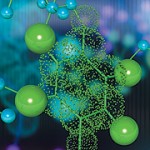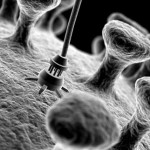
Wikimedia
What do the Gulf oil spill, the attacks on the World Trade Center on September 11, 2001, and nanotechnology have in common? On the surface, it would seem to be nothing. But all three involve responses to potential health and environmental threats that are instructive about how we as a society respond to such threats. Collectively, they raise some important issues regarding how our society views health and environmental risks in general.
Don’t get me wrong. In no way am I suggesting that nanotechnology is comparable to the disasters at Ground Zero or in the Gulf. Rather, I am asking that you look at how government and funded research institutes manage long-term health and environmental effects that occur as a result of chronic low-dose exposures over time. The potential health hazards of nanotechnology fall into the long-term category. We don’t expect to see any acute health problems associated with nanotechnology, but we should be concerned about long-term exposures, and existing efforts to study the effects should be expanded.
Let’s contrast what happens when there is a disaster.
On August 19, 2010, administration officials reaffirmed their commitment to the recovery and restoration of the Gulf in the aftermath of the Deepwater Horizon oil rig explosion and the subsequent movement of oil into the waters and the ecosystems of the Gulf. The media outlets have been full of video, photographs, and articles about the efforts of many organizations, companies, and governmental entities to clean up and minimize the potential harm to natural resources, the environment, and all forms of life.
Not so long ago, something similar went on at Ground Zero in the aftermath of the collapse of the World Trade Center towers following the 9/11 terrorist attacks. Early on, the focus of efforts at Ground Zero was on the search for survivors. On September 29, the focus turned to recovery and cleanup, including removal of debris. But even before that date, the federal, state, and local governments were engaged in managing the environmental disaster that resulted from the release of hazardous substances into the air, including asbestos, silica, lead, mercury, polycyclic aromatic hydrocarbons (PAHs), dioxin, polyvinyl chloride (PVC), Freon, and polychlorinated biphenyls (PCBs), to name a few. Workers from FDNY, NYPD, Port Authority of New York and New Jersey, emergency medical personnel, and a host of volunteers worked at the site.
It is easy to assign massive resources to the acute phase of a disaster, but much harder to sustain interest and funding as time goes on. Eventually the media will move on to other stories now that the Macondo well is just about sealed, as it eventually did when the cleanup at Ground Zero was completed. Funds have been established to make payments, lawsuits commenced. But what lingers is the reality of long-term health effects that could emerge over time – ecosystem damage or cancer or other health risks. Society has a certain myopia about such things. Perhaps it is human nature to not want to think about the health problems that could arise years down the line.
The protracted task of developing valid scientific studies on the health effects of any exposures, including nanoparticles, and interpreting the results is as essential as responding to the acute phase of a disaster. Disasters like the Gulf spill and 9/11 suggest a kind of false dichotomy – that acute harms are more worthy of recognition in the law than chronic long-term harms. The long-term harms may seem less urgent, but there is nevertheless an urgency about them as well.
For example, following the Exxon Valdez oil spill in 1989, no concerted effort was made to assess the health effects of the cleanup on workers. Years later, surveys told the story of respiratory and neurological illness. This month, the National Institute of Environmental Health Sciences announced it would begin a study of the potential health effects of exposures of workers and residents as a result of the Gulf oil spill. Even in the 9/11 context, where health screenings of Ground Zero responders have been ongoing since 2002, and a data base has been established, acceptable compensation has come nearly a decade after the disaster. The law is slower to recognize the harms from chronic exposures, and slower to act to both compensate the injured and prevent further harm. Clearly, some of this is a result of symptoms and other harms emerging over time. But this is all the more reason to be vigilant and investigative from the start.
Far from the spotlight of a high-profile disaster, and in the absence of a clearly exposed population to screen, studies on the health and environmental effects of exposures to substances about which we know little is essential.
As mentioned, nanotechnology is not a disaster. Far from it. It is a means for creating better medical therapies, making some of our technology perform better, and offering consumers desirable features in everyday products such as textiles and cosmetics. But this does not eliminate the need to make a concerted effort to study the long-term health and environmental effects of nanoparticles and nanomaterials. No matter how long it takes; no matter how far out of the spotlight.
For those interested in knowing more about the toxic aftermath of Ground Zero, see my article, Toxic Torts at Ground Zero, 39 ARIZ. ST. L.J. 383 (2007).
On the need for studies of the health impact of the Gulf spill, see
Gina M. Solomon & Sarah Janssen, Health Effects of the Gulf Oil Spill, J.A.M.A. (Aug. 16, 2010), available at http://jama.ama-assn.org/cgi/content/full/jama.2010.1254v1


 The National Academies have promised a report by the end of January 2012 on priorities (both short- and long-term) for studying the health, safety, and environmental effects of nanotechnology. According to the National Academies, this report will address the following matters: the properties of engineered nanomaterials; methods and technologies for “detecting, measuring, analyzing, and monitoring” engineered nanomaterials; what studies are needed; what testing methods need to be developed; the models for predicting impacts that should be developed; research priorities; and the criteria for evaluating research progress. In its “Statement of Task,” the National Research Council has explained:
The National Academies have promised a report by the end of January 2012 on priorities (both short- and long-term) for studying the health, safety, and environmental effects of nanotechnology. According to the National Academies, this report will address the following matters: the properties of engineered nanomaterials; methods and technologies for “detecting, measuring, analyzing, and monitoring” engineered nanomaterials; what studies are needed; what testing methods need to be developed; the models for predicting impacts that should be developed; research priorities; and the criteria for evaluating research progress. In its “Statement of Task,” the National Research Council has explained: In a June 9, 2011, memorandum to the heads of U.S. executive departments and agencies, entitled Policy Principles for the U.S. Decision-Making Concerning Regulation and Oversight of Applications of Nanotechnology and Nanomaterials, the White House confirmed its commitment to a “science-based” approach to health and safety matters related to nanotechnology. The memorandum issued from the Office of Science and Technology Policy, the Office of Management and Budget, and the Office of the U.S. Trade Representative. The memorandum described its approach as
In a June 9, 2011, memorandum to the heads of U.S. executive departments and agencies, entitled Policy Principles for the U.S. Decision-Making Concerning Regulation and Oversight of Applications of Nanotechnology and Nanomaterials, the White House confirmed its commitment to a “science-based” approach to health and safety matters related to nanotechnology. The memorandum issued from the Office of Science and Technology Policy, the Office of Management and Budget, and the Office of the U.S. Trade Representative. The memorandum described its approach as
 The New York Times recently published an article reviewing the state of research on the adverse health effects of the chemical bisphenol-A (known as BPA), which is found in plastic used for many consumer products. BPA is a hot topic right now, both in the health and political arenas. The reason is that BPA has been shown in some studies to mimic the hormone estrogen, which is considered an “endocrine disruptor” capable of causing harm to humans. But whether BPA, in mimicking estrogen, actually causes harm has yet to be determined.
The New York Times recently published an article reviewing the state of research on the adverse health effects of the chemical bisphenol-A (known as BPA), which is found in plastic used for many consumer products. BPA is a hot topic right now, both in the health and political arenas. The reason is that BPA has been shown in some studies to mimic the hormone estrogen, which is considered an “endocrine disruptor” capable of causing harm to humans. But whether BPA, in mimicking estrogen, actually causes harm has yet to be determined.
